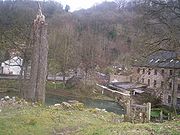
Via Gellia
Encyclopedia

Derbyshire
Derbyshire is a county in the East Midlands of England. A substantial portion of the Peak District National Park lies within Derbyshire. The northern part of Derbyshire overlaps with the Pennines, a famous chain of hills and mountains. The county contains within its boundary of approx...
.
It is probably named after (or by) Phillip Eyre Gell in a mock Latin
Latin
Latin is an Italic language originally spoken in Latium and Ancient Rome. It, along with most European languages, is a descendant of the ancient Proto-Indo-European language. Although it is considered a dead language, a number of scholars and members of the Christian clergy speak it fluently, and...
style; he was responsible for building the road through the valley, and the Gells claimed Roman descent. At its lower (eastern) end is the village of Cromford
Cromford
Cromford is a village, two miles to the south of Matlock in the Derbyshire Dales district in Derbyshire, England. It is principally known for its historical connection with Richard Arkwright, and the Cromford Mill which he built here in 1771...
, near to the town of Wirksworth
Wirksworth
Wirksworth is a small market town in Derbyshire, England, with a population of over 9,000.The population of the Wirksworth area including Cromford, Bolehill and Middleton-by-Wirksworth is about 12,000. Wirksworth is listed in the Domesday Book in 1086. Within it is the source of the River...
and the Georgian cotton mill, Cromford Mill, built by inventor/entrepreneur Richard Arkwright
Richard Arkwright
Sir Richard Arkwright , was an Englishman who, although the patents were eventually overturned, is often credited for inventing the spinning frame — later renamed the water frame following the transition to water power. He also patented a carding engine that could convert raw cotton into yarn...
. At the western end is the hamlet of Grangemill
Grangemill
Grangemill is a busy crossroads village in the English county of Derbyshire. It is made up of a cluster of houses, a farm and a pub called the Hollybush. There is a former cheese factory in the village, and the workings of this are still on display....
.
The road (now the A5012
A5012 road
The A5012 road is a main road in the south of the English county of Derbyshire.Around in length it connects two primary north-south routes, the A6 at Cromford and the A515 between Buxton and Ashbourne...
) appears to have been constructed about 1790 to connect the Gell family
Gell Baronets
The Gell Baronetcy, of Hopton in the County of Derby, was a title in the Baronetage of England. It was created on 29 January 1642 for John Gell, Hopton Hall, Derbyshire, chief barmaster in the wapentake of Wirksworth from 1638–1644. The family gained importance and wealthy through their lead...
's extensive lead-mining interests around Wirksworth
Wirksworth
Wirksworth is a small market town in Derbyshire, England, with a population of over 9,000.The population of the Wirksworth area including Cromford, Bolehill and Middleton-by-Wirksworth is about 12,000. Wirksworth is listed in the Domesday Book in 1086. Within it is the source of the River...
with a new smelter at Cromford. However, some sources say that the route was in use as early as 1720 for transporting stone from the Gell's quarries in the Hopton
Hopton, Derbyshire
Hopton is a hamlet in the English county of Derbyshire.It is south west of Wirksworth and at the northern end of Carsington Water.The village had a long association with the Gell family who had extensive lead mining interests in the Wirksworth area and lived at Hopton Hall...
area.
The fabric Viyella
Viyella
Viyella was a blend of wool and cotton first woven in 1893 in England, and soon to be the "first branded fabric in the world". It was made of 55 percent merino wool and 45 percent cotton in a twill weave, developed by James and Robert Sissons of William Hollins & Company, spinners and hosiers...
, a wool/cotton mix, is named after the Via Gellia valley, the location of W. Hollins & Company's textile mill where it was originally produced.
Modern history
In modern times the Via Gellia developed a reputation as being a dangerous road with a disproportionately high casualty rate, particularly among motorcyclists. This was due in part to its relative narrowness, the number of large goods vehicles using it to access the quarries, and its canopy of overhanging trees resulting in a persistently damp surface. Remedial measures, including resurfacing, were carried out by Derbyshire County Council in 2006.External links
- British Geological Survey Page
- http://www.wirksworth.org.uk/X203.htm - Old Picture and Viyella ref

